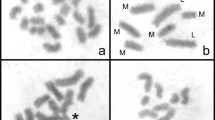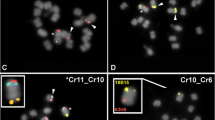Abstract
Detailed karyological surveys of the ant Myrmecia pilosula species group, which is characterized by the lowest chromosome number in higher organisms (2n=2), were attempted. We revealed that this species has developed highly complicated chromosomal polymorphisms. Their chromosome numbers are in the range 2n=2, 3, and 4, and six polymorphic chromosomes are involved, i.e., two for chromosome 1 (denoted as SM1 and ST1), three for chromosome 2 (A2, A′2, and M2), and M(1+2) for the 2n=2 karyotype. We suggested that these chromosomes were induced from a pseudo-acrocentric (A M1 ) and A2 as follows: (1) A M1 →SM1 or ST1 by two independent pericentric inversions; (2) A2→A′2→M2 by chromosomal gap insertion and centromere shift; and (3) ST1+A2→M(1+2) by telomere fusion, where (3) means that the 2n=2 karyotype was derived secondarily from a 2n=4 karyotype. It is a noteworthy finding that active nucleolus organizer (NOR) sites, in terms of silver staining, are tightly linked with the centromere in this species, and that both the centromere and NOR of A2 were inactivated after the telomere fusion.
Similar content being viewed by others
References
Brown WL Jr (1953) Revisionary notes on the ant genus Myrmecia of Australia. Bull Mus Comp Zool Harv III:1–35
Clark J (1954) The Formicidae of Australia. Vol 1 Subfamily Myrmicinae. CSIRO, Melbourne, pp 230
Crosland MWJ, Crozier RH (1986) Myrmecia pilosula, an ant with only one pair of chromosomes. Science 231:1278
Crosland MWJ, Crozier RH, Imai HT (1988) Evidence for several sibling biological species centered on Myrmecia pilosula (F SMITH) (Hymenoptera: Formicidae). J Aust Entomol Soc 27:13–14
Howell WM, Black DA (1980) Controlled silver-staining of nucleus organizer regions with a protective colloidal developer: a 1-step method. Experientia 36:1014–1015
Imai HT (1988) Centric fission in man and mammals. In: Daniel A (ed) The cytogenetics of mammalian autosomal rearrangements. Alan R Liss, New York, pp 551–582
Imai HT, Crozier RH (1980) Quantitative analysis of directionality in mammalian karyotype evolution. Am Nat 116:537–569
Imai HT, Crozier RH, Taylor RW (1977) Karyotype evolution in Australian ants. Chromosoma 59:341–393
Imai HT, Taylor RW, Crosland MWJ, Crozier RH (1988a) Modes of spontaneous chromosomal mutation and karyotype evolution in ants with reference to the minimum interaction hypothesis. Jpn J Genet 63:159–185
Imai HT, Takahata N, Maruyama T, Daniel A, Honda T, Matsuda Y, Moriwaki K (1988b) Theoretical bases for karyotype evolution. II The fusion burst in man and mouse. Jpn J Genet 63:313–342
Palomeque T, Chica E, Cano MA (1988) Karyotypes, C-banding, and chromosomal location of active nucleolar organizing regions in Tapinoma (Hymenoptera, Formicidae). Genome 30:277–280
Author information
Authors and Affiliations
Rights and permissions
About this article
Cite this article
Imai, H.T., Taylor, R.W. Chromosomal polymorphisms involving telomere fusion, centromeric inactivation and centromere shift in the ant Myrmecia (pilosula) n=1 . Chromosoma 98, 456–460 (1989). https://doi.org/10.1007/BF00292792
Received:
Revised:
Issue Date:
DOI: https://doi.org/10.1007/BF00292792




